Otherworldly trees and rocks at Joshua Tree National Park
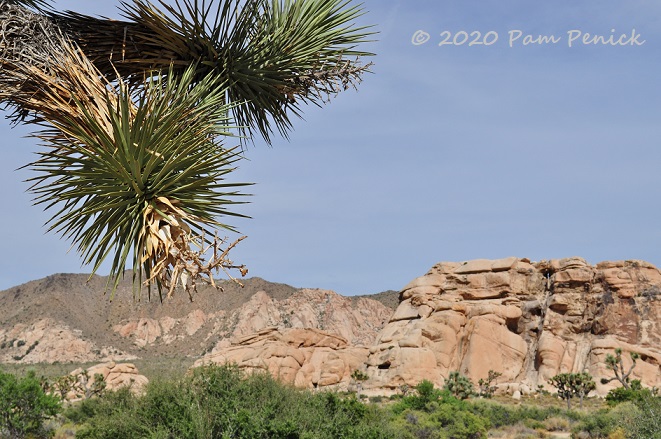
Oh hi! Let’s pop back into the national park road trip. From the central coast of California, back in late June, we headed home to Austin via a more southerly route than our outbound one.
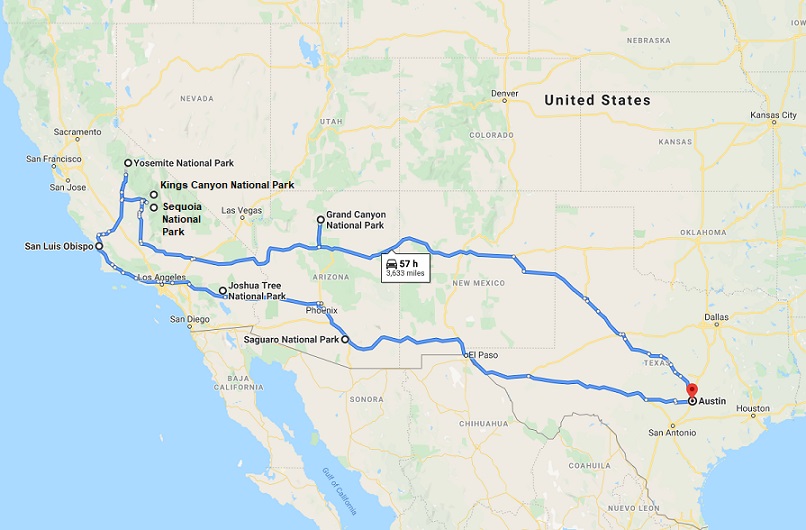
We zipped through Los Angeles — regretful that the pandemic prevented any visits with friends — and pressed on to Palm Springs.
Palm Springs
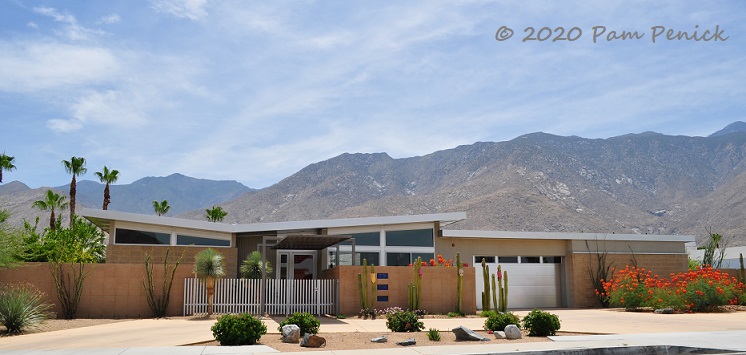
In the desert oasis of Palm Springs we cruised through town checking out the mid-century architecture and desert gardens. A home-and-garden tour would be worth a return visit one day! After a picnic lunch at a local park, we drove on to Joshua Tree National Park‘s west entrance, about 30 miles away.
Joshua Tree National Park
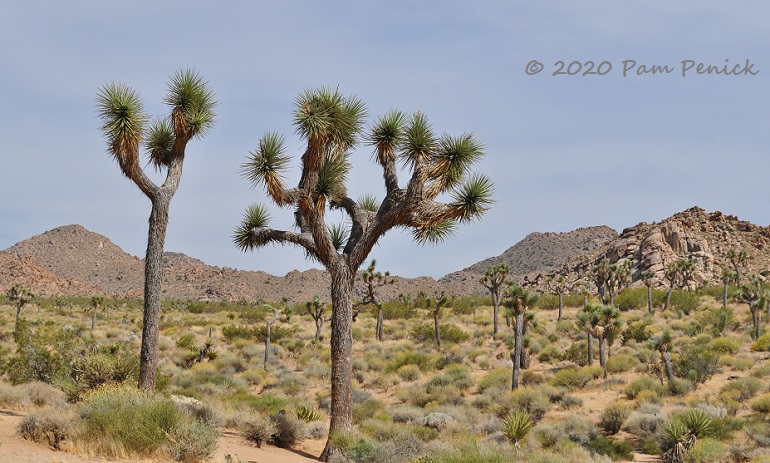
Joshua Tree straddles two of California’s forbiddingly beautiful deserts, the Mojave and the Colorado, which is part of the vast Sonoran Desert. The Colorado, on the park’s less-traveled southeastern side, is low desert with elevations below 3,000 feet. The Mojave, on the northwestern side, is high desert with elevations between 3,000 and 5,000 feet.
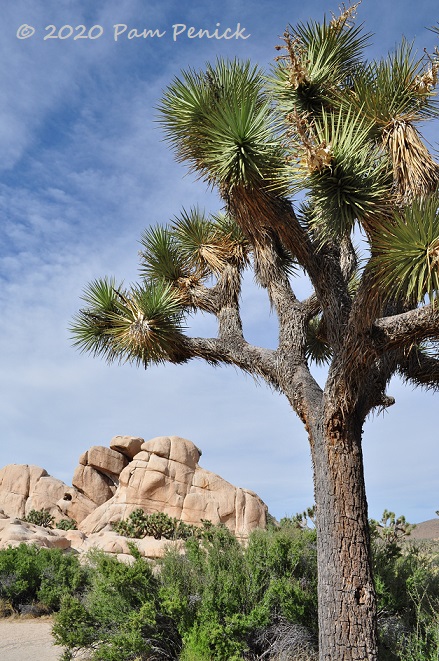
On the Mojave side you find the curious-looking Joshua tree, which isn’t a tree at all but a tall, trunking yucca — Yucca brevifolia to be exact.
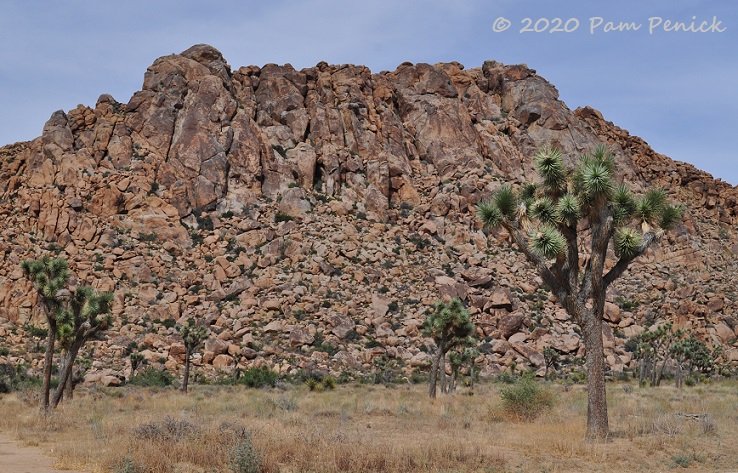
And who was Joshua? According to legend, the Joshua tree was named by Mormon settlers, who anthropomorphized the yucca, seeing in its posture the raised arms of the Biblical figure Joshua.
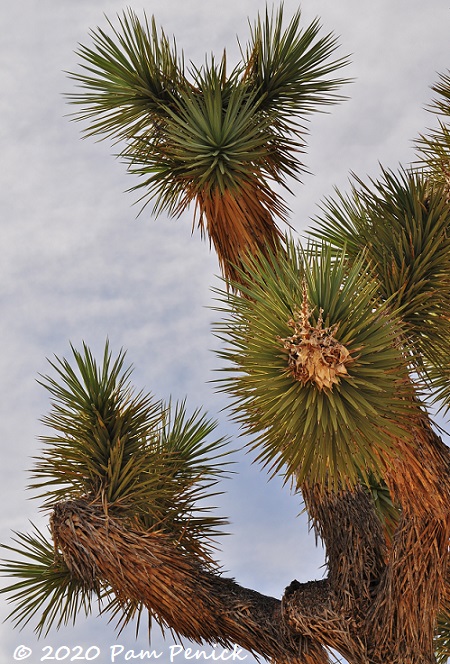
They do seem vaguely human-shaped, with multiple arms and heads — perhaps more alien than human.
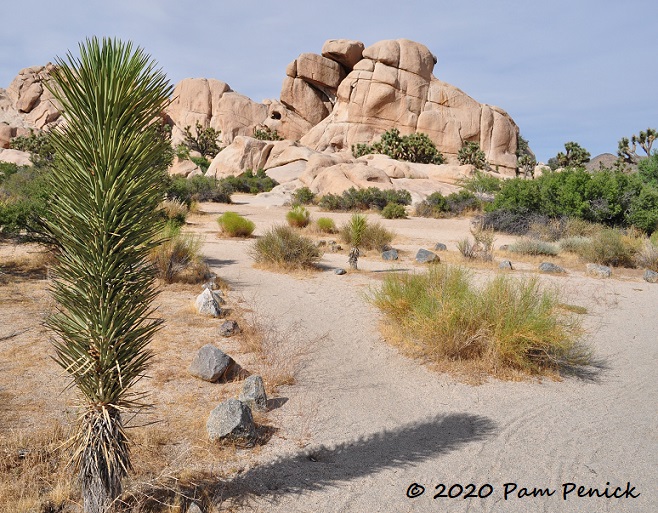
Young Joshua trees look like this: a bristling column with no branching arms. Branching comes later, after the yucca has flowered.
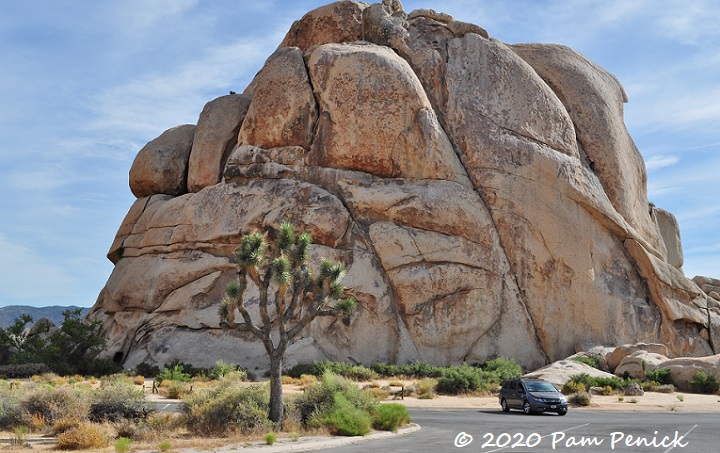
As otherworldly as the Joshua tree, massive granite boulders and mini-mountains dot the landscape as if plonked here from outer space. E.T. didn’t bring them though. These rounded and fissured, pale-pink rocks were formed underground millions of years ago, when magma rose toward the surface and eventually cooled, cracked, and uplifted. Groundwater sanded down the rough edges, widened the cracks, and exposed the rocks to view. Today they attract rock climbers, boulderers, and slackliners from around the world.
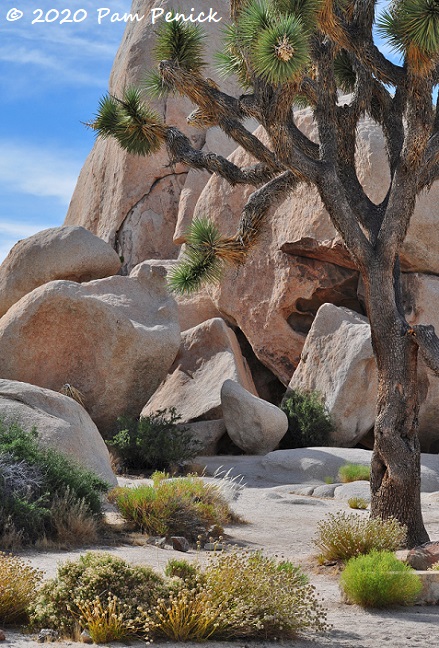
Plenty of other plants make up a supporting cast for the Joshua tree, like California buckwheat.
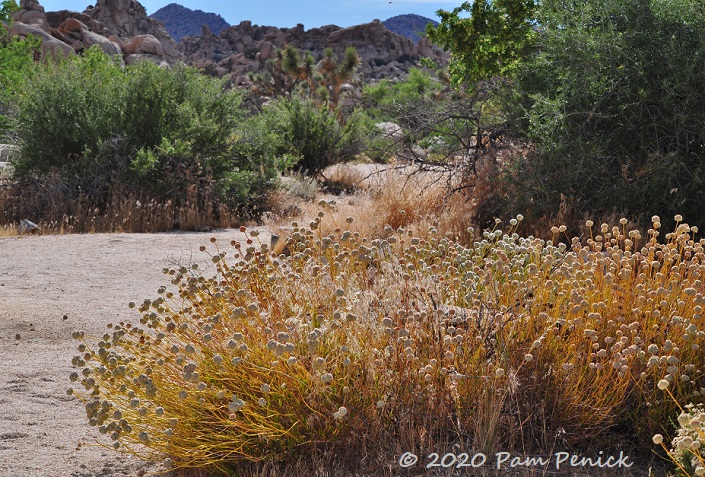
I adore this plant, with its cute button-headed flowers.
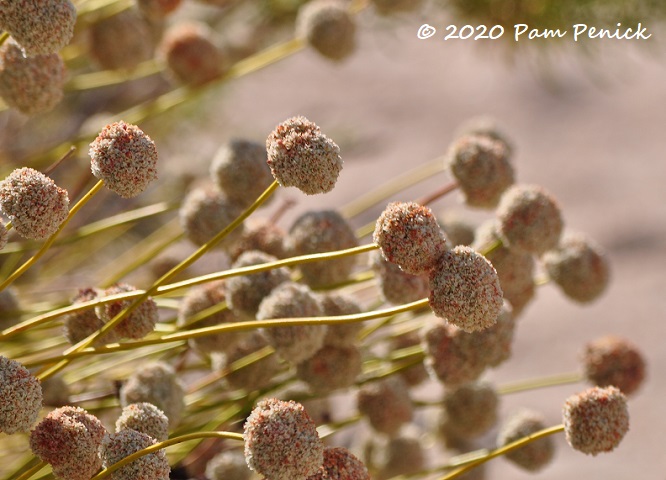
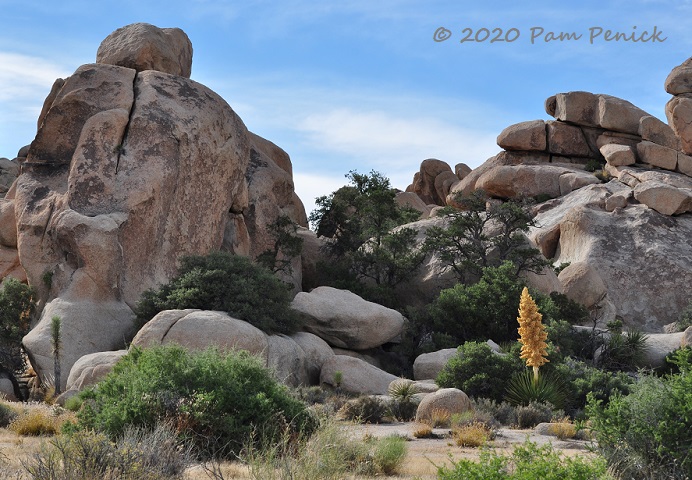
Parry’s nolina (Nolina parryi) was flowering throughout the park in late June, its enormous, foxtail-shaped bloom spike giving away its location.
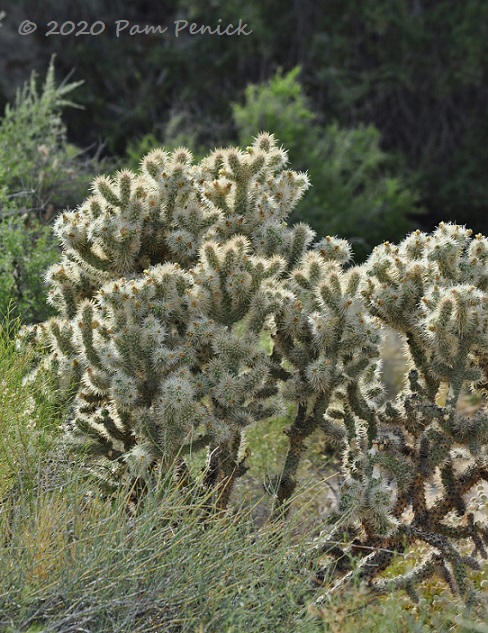
Teddy-bear cholla appeared here and there, but we’d soon see 10 terrifying acres of it at the Cholla Cactus Garden (photos below). Why terrifying? Its cylindrical “branches,” which look almost cuddly when the light catches the blond spines, easily detach if you brush against them (or pick one up on your shoe) and embed their barbed spines into your skin. Watch this video to see how fun it looks when a cholla pad attaches to someone’s bare leg (be aware there is understandable cursing).
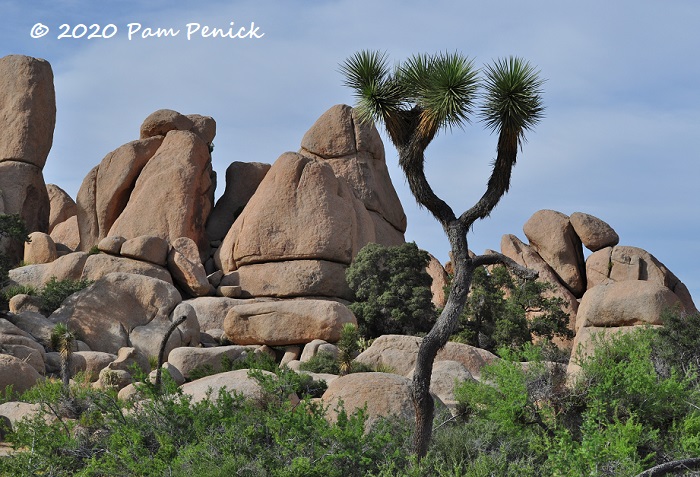
An undulating Joshua tree echoes the round shapes of the rocks.
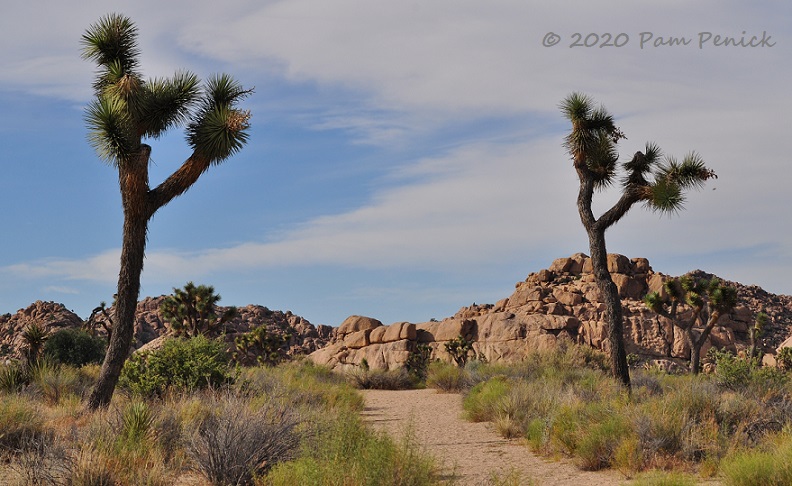
Amazingly for midsummer, it wasn’t unbearably hot on the day we visited. I remember it being in the mid-80s. So we were able to explore a short trail or two, although mostly we took in the sights from pull-outs along the way.
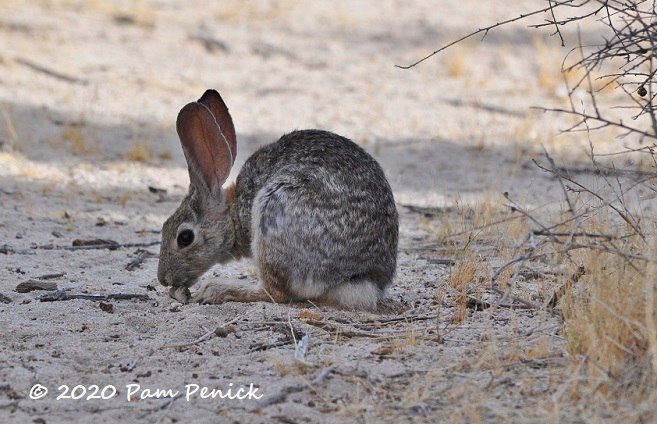
We spotted a desert cottontail resting in the shade.
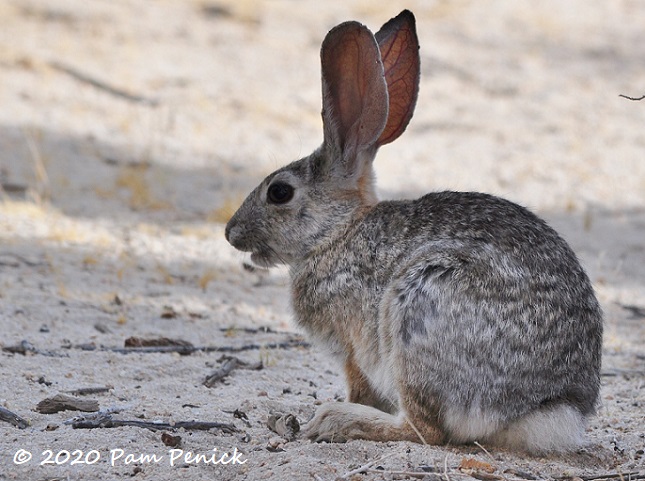
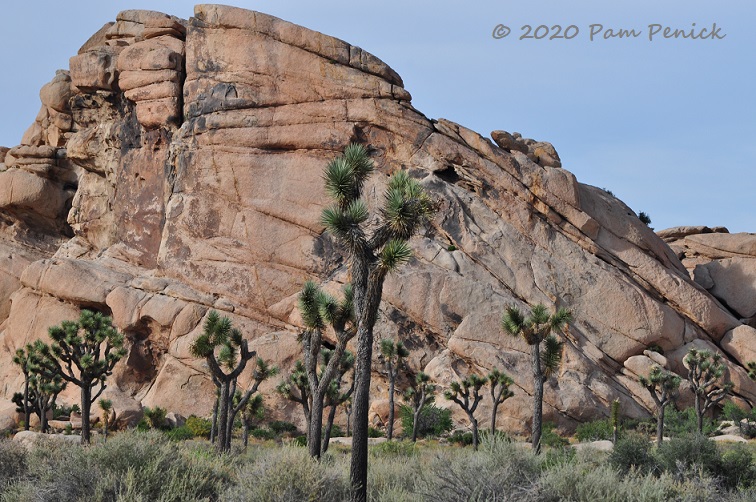
And vista after vista like this.
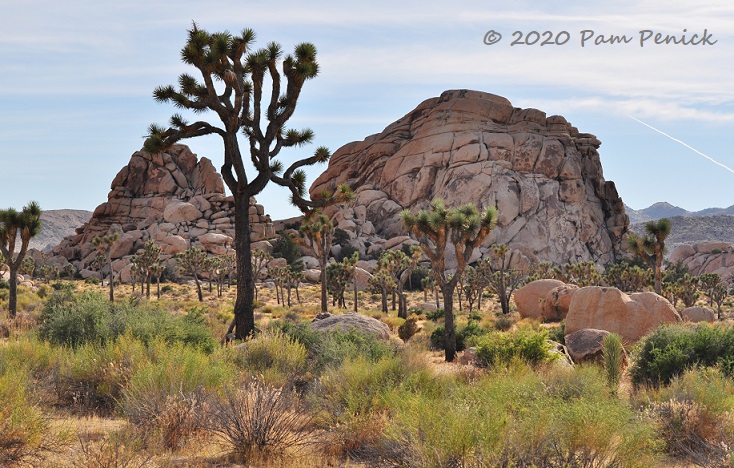
As the sun slid down the sky, the light got better, illuminating fine-textured plants and casting a warm glow on the rocks.
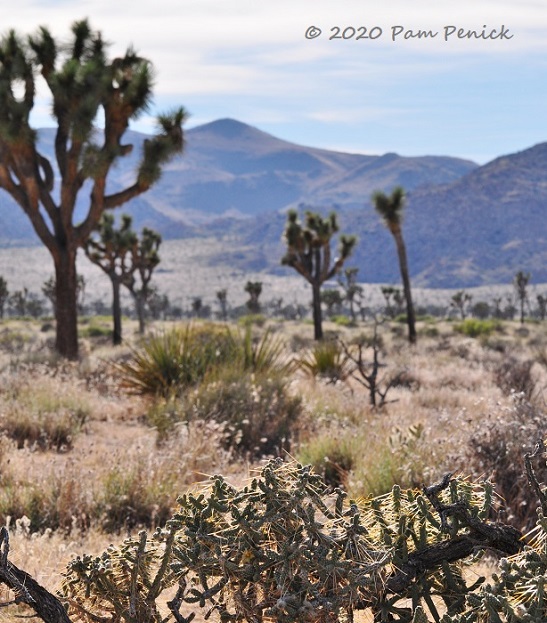
More cholla — not the teddy-bear kind — with Joshua trees and the Little San Bernardino Mountains in the distance. Or are these the Hexie Mountains? Both ranges march across the park.
Keys View
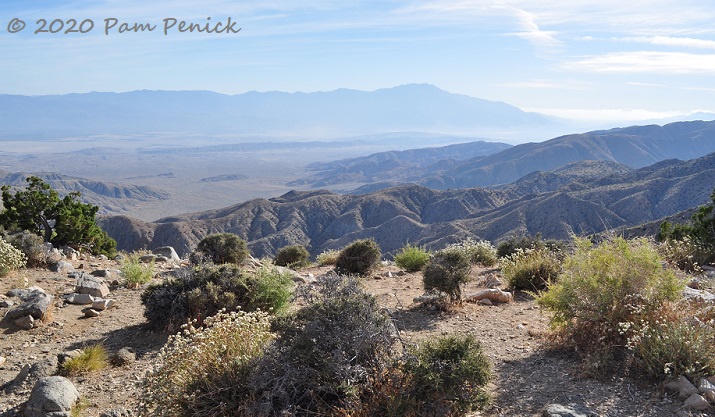
A 20-minute drive took us up to Keys View, the highest point in the park at 5,185 feet.
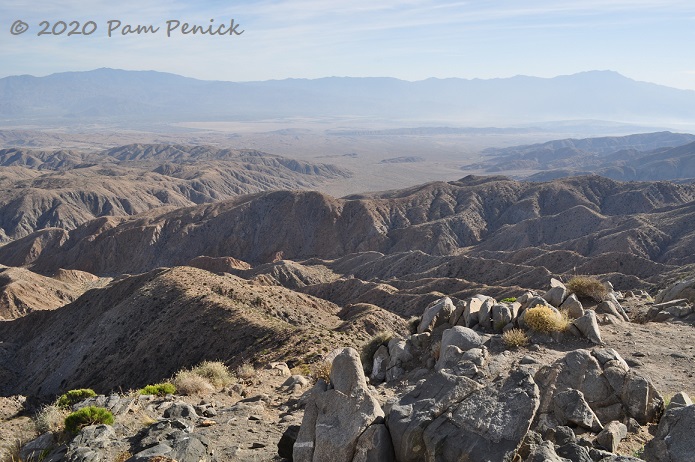
From here you can see the Coachella Valley, the Salton Sea, and even the San Andreas Fault.
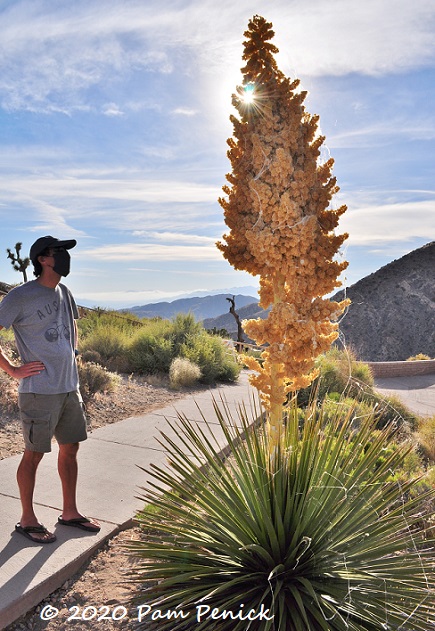
A high overlook can’t compare to seeing this bad boy up close though! Check out the monstrously large bloom spike on a Parry’s nolina. I got 6-foot-tall David to pose beside it for scale.
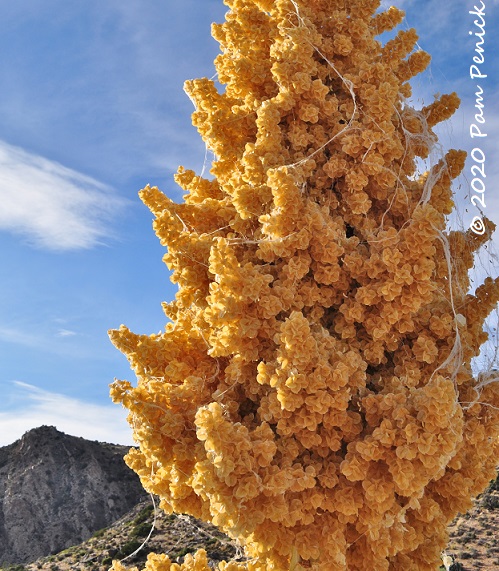
Online sources say the flowers of Parry’s nolina are white. All the ones we saw were going to seed and had turned a lovely maize-yellow, and this one was festooned with gauzy silk…
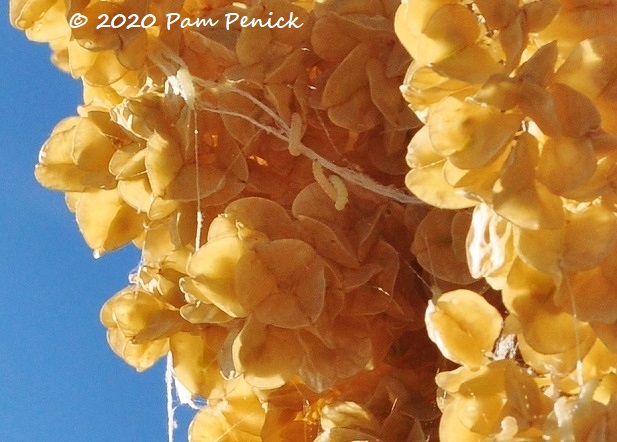
…from caterpillars?
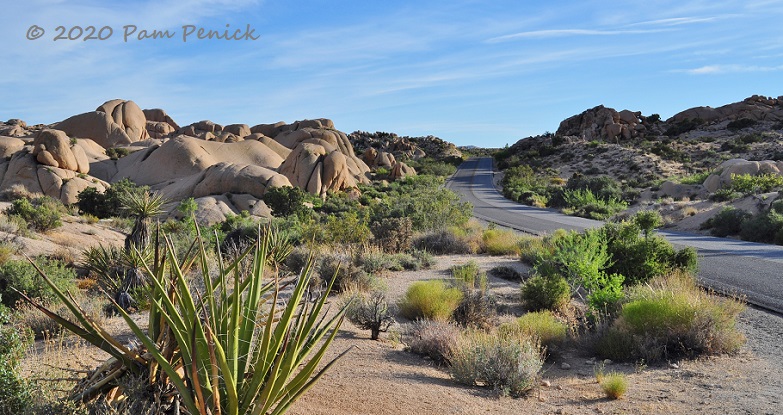
The desert road
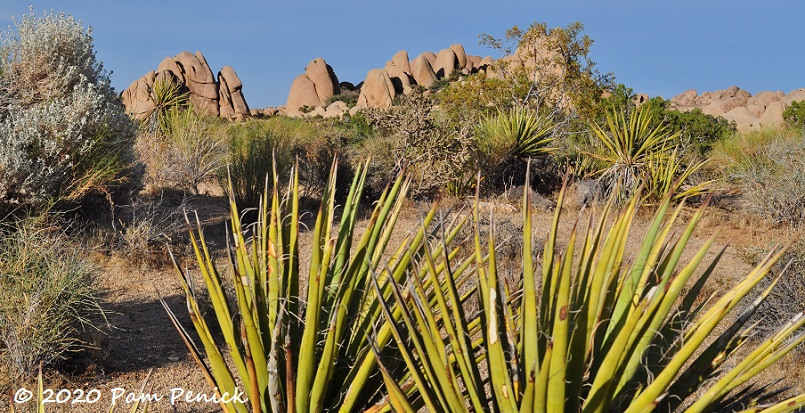
Skull Rock
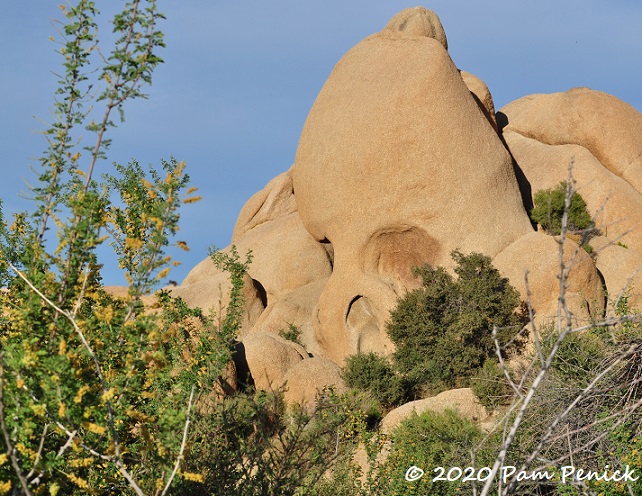
It’s impossible not to squint at the rocks of Joshua Tree, as with clouds, and see animals or faces in them. Apparently everyone agreed on this one, and it’s called Skull Rock.
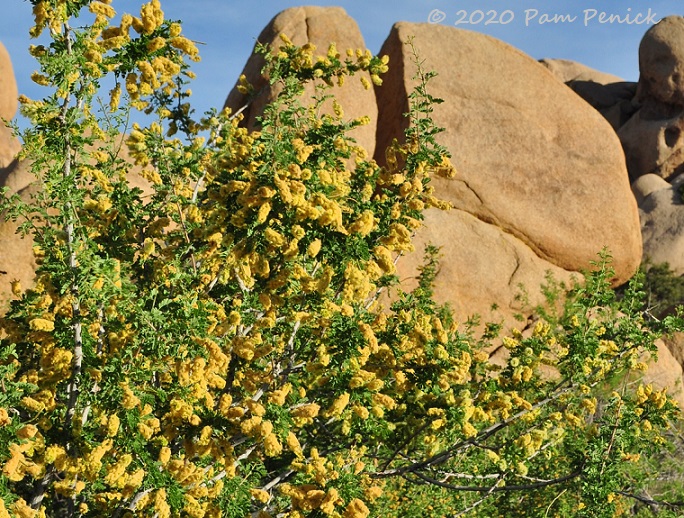
A flowering shrub nearby, maybe an acacia?
Cholla Cactus Garden
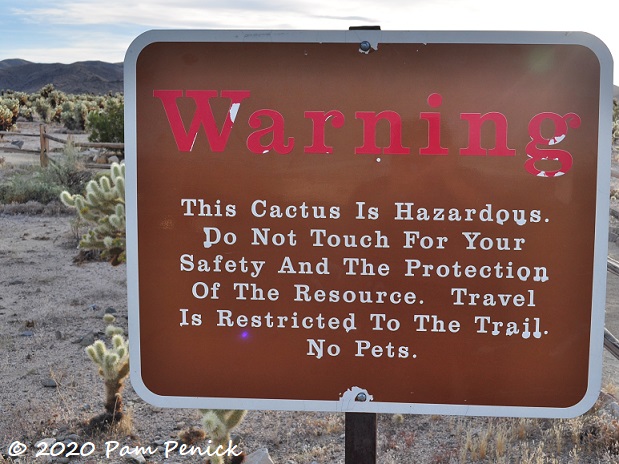
As soon as I unfolded the park map and saw Cholla Cactus Garden marked on the Colorado Desert side, I knew I wanted to see it at the golden hour. Entranced by Joshua Tree, we’d made a lot of stops along the way, and so we had to hustle to get there in time.
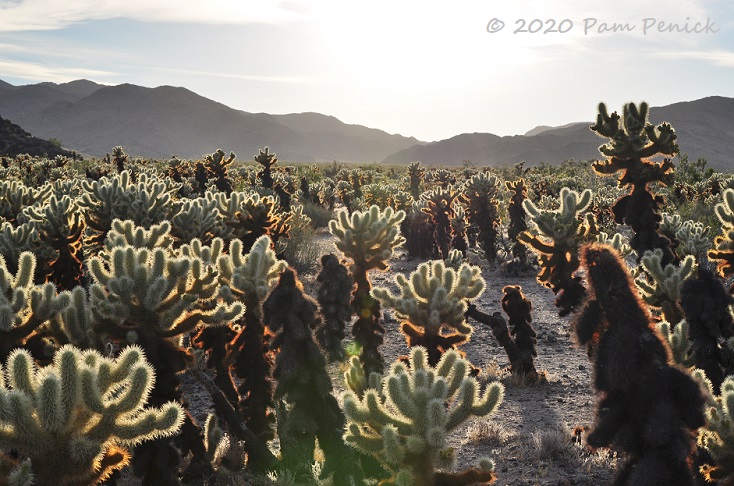
But we did. Our reward was acres of incandescent, “fuzzy” teddy-bear chollas.
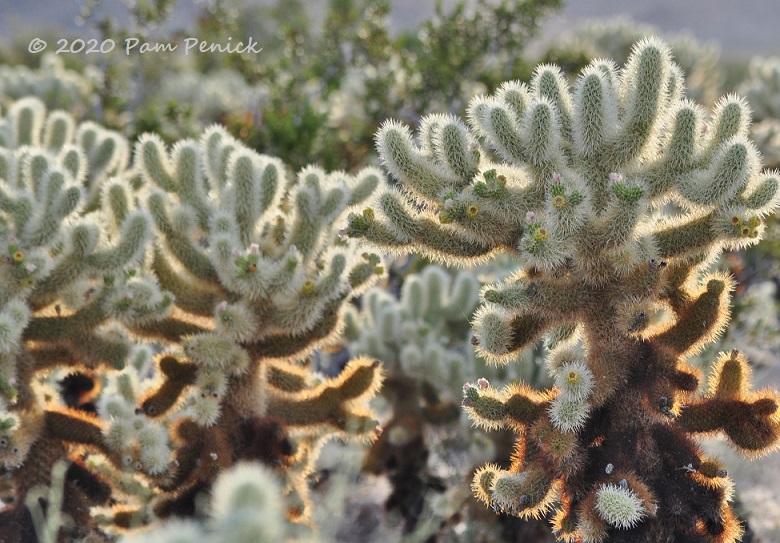
An elevated boardwalk leads through this natural cactus “garden,” safe from stray cholla pads lying on the ground, although plenty were within arm’s reach.
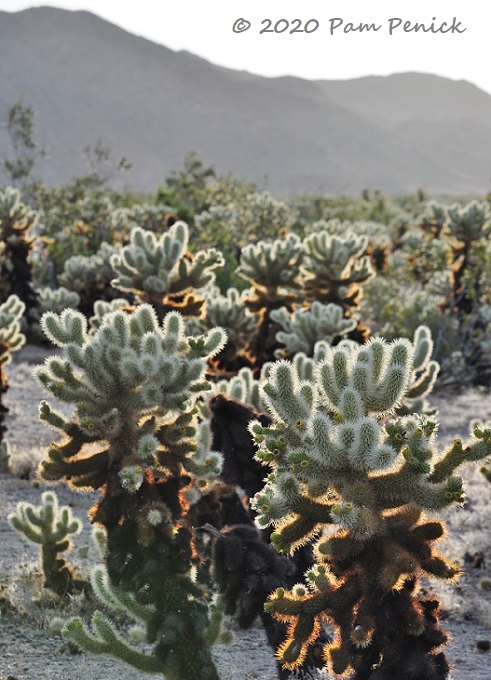
Mahogany-hued trunks of old pads support white-spined crowns.
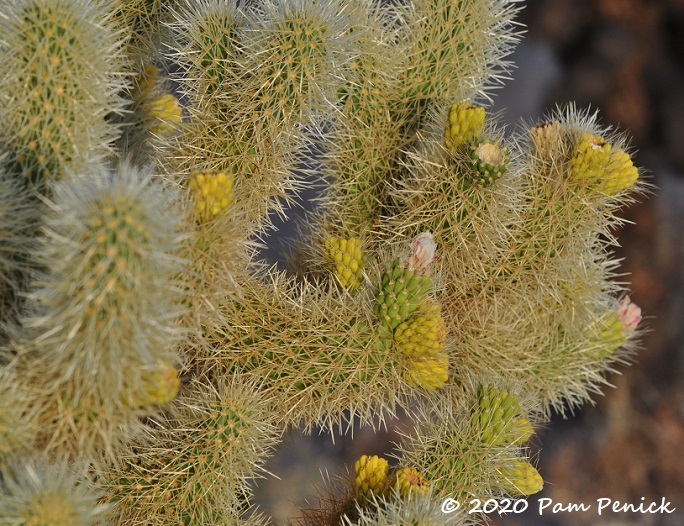
A close-up look — super spiny!
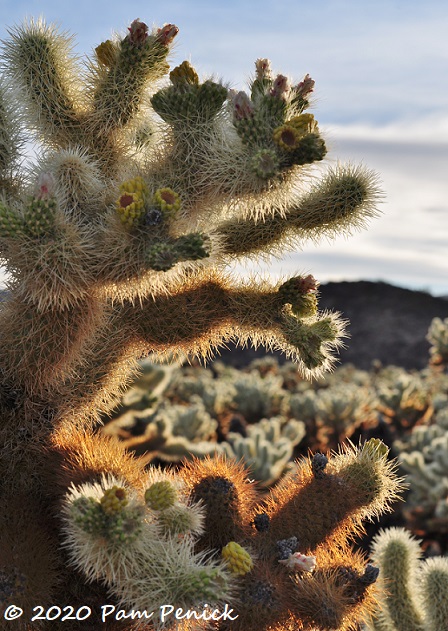
Uh-oh, it looks like this one is coming in for a hug.
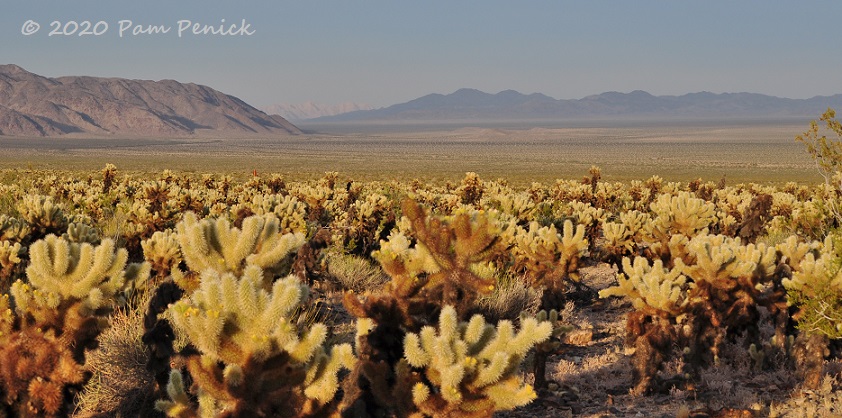
Cholla and distant lavender mountains — a harsh and dangerous landscape, but with its own beauty.
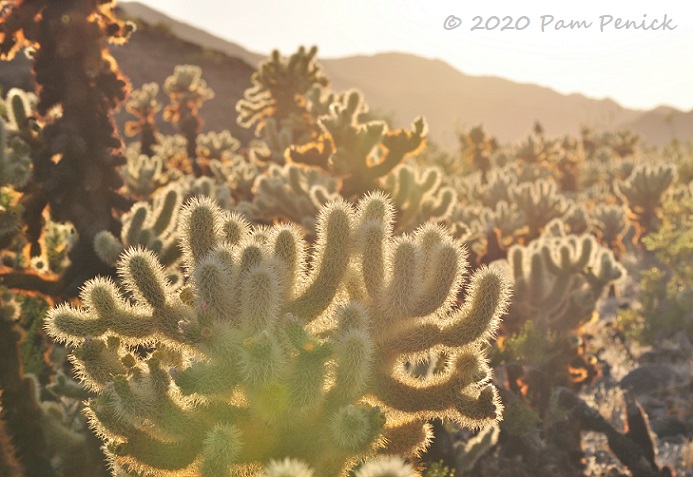
Golden hour — boom!
Up next: My final park visit, Saguaro National Park in Arizona. For a look back at the wildflowers and birds of Montaña de Oro State Park on the central California coast, click here.
__________________________
Digging Deeper
Come learn about gardening and design at Garden Spark! I organize in-person talks by inspiring designers, landscape architects, authors, and gardeners a few times a year in Austin. These are limited-attendance events that sell out quickly, so join the Garden Spark email list to be notified in advance; simply click this link and ask to be added. Season 8 kicks off in fall 2024. Stay tuned for more info!
All material © 2025 by Pam Penick for Digging. Unauthorized reproduction prohibited.


Pam, I always loved those granite formations around Arizona. There are those Granite Dells up around Prescott and I’m sure you went through Texas Canyon on the way back east of Tucson, on IH10. It’s almost like being on another planet for a bit.
The western landscape wowed me all the way out to California. I may have been sleeping through Texas Canyon because I don’t remember it specifically — ha! — but yes, the vastness and strangeness of the scenery out that way does make you feel you’re on another planet. It also makes you remember how big the world really is.
Those photos of the Cholla Cactus Garden are fabulous….. even for you!
Note to self: buy Nolina Paryii
Thanks, Paula. 🙂 And yes to the nolina! I wonder how it’ll do in the Texas Hill Country? There’s only one way to find out!
Every one of your horizontal photos felt like I was looking at a vintage postcard. What great light and you captured the magic so wonderfully.
Thanks, Loree. I felt very lucky to be there when it was relatively cool and to catch that cholla garden as the sun was going down.
Beautiful photos. I really enjoyed this post. Thanks for the map, too!
Thanks for coming along on my virtual tour, Leslie!
It may have been cool while you were there, lucky you, but the photos with all of those desert plants looked hot to me. Great photos. I don’t remember ever seeing a nolina bloom. WOW. Those chollas make me miserable just looking at them. ha… I always wondered where the writer found ‘Purple Mountains Majesty’ until I was in AZ. Saw them all over the place. 🙂
Thanks, Lisa. And yes, those chollas are best seen and not touched.
wooooowzers! that virtual tour of Joshua Tree National Park was sensational. Definitely a bucket list item.
I’m so glad you enjoyed it, Sona!
Anything on Euphorbia?
Not that I noticed, Jeffry.